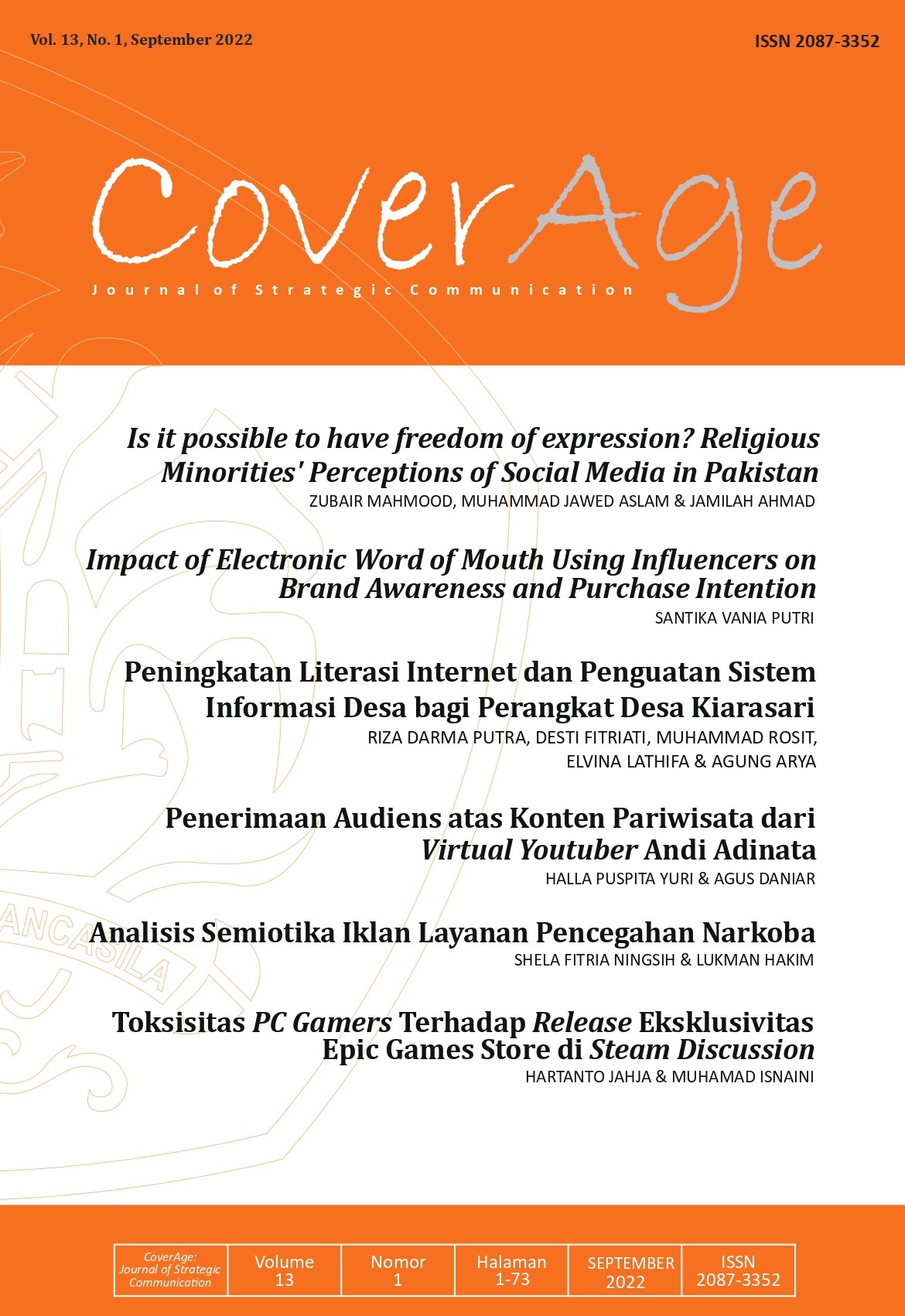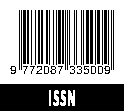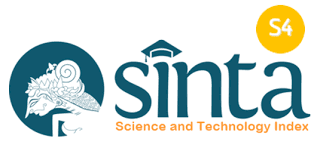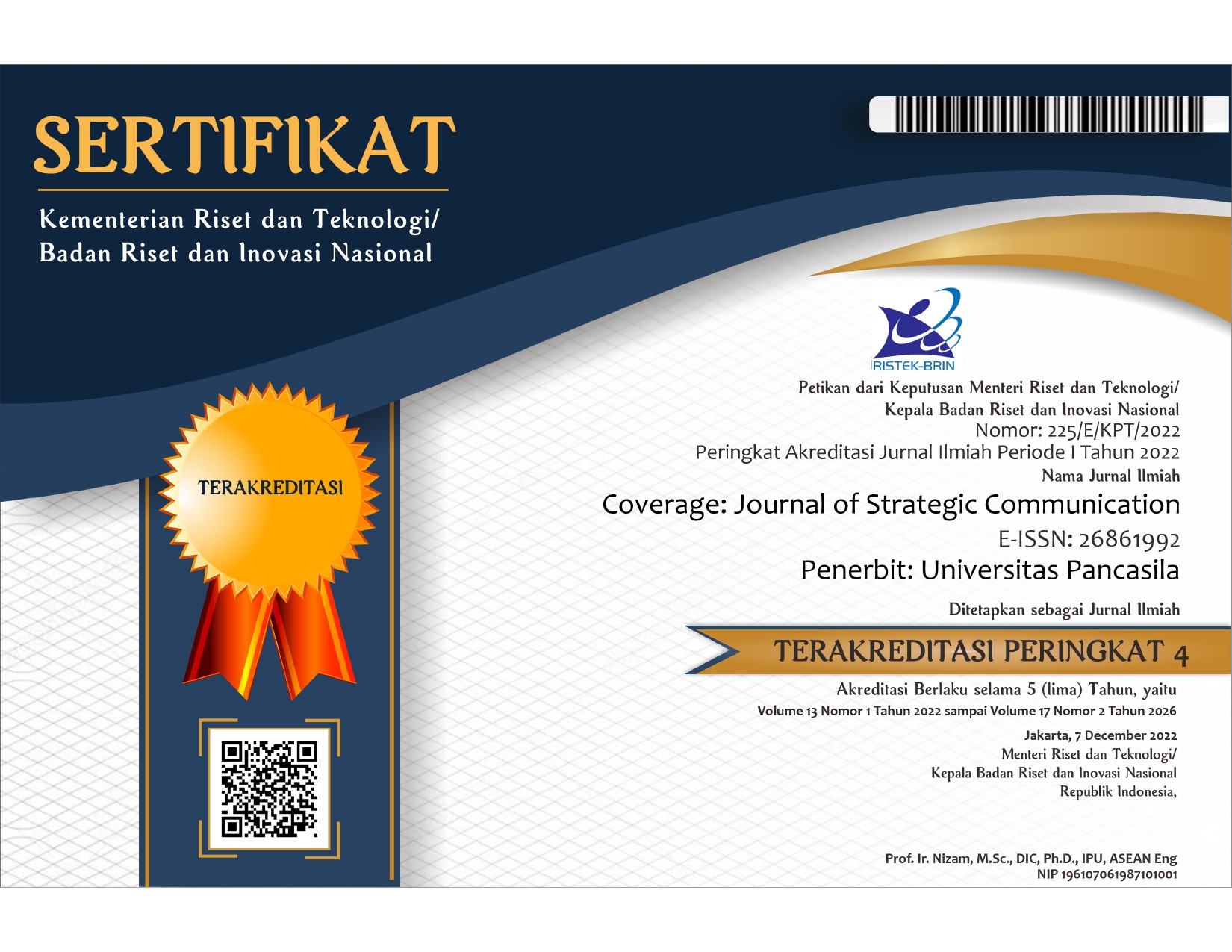The Impact of Electronic Word of Mouth (EWOM) Using Influencers on Brand Awareness and Purchase Intention
DOI:
https://doi.org/10.35814/coverage.v13i1.3913Keywords:
eWOM, Brand Awareness, Buzz Marketing, Influencer, Purchase, IntentionAbstract
Digitalization has transformed individuals’ behaviour in receiving information. The changes has encourage marketer to shift their marketing strategy, from offline to online. With the existence of internet, Word of Mouth (WOM) strategy has converted to electronic Word of Mouth (eWOM)with the help of social media. eWOM itself has an advantage of raising awareness of a product, service, or a brand itself. Adopting the eWOM concept, there comes a new marketing strategy called buzz marketing, in which usually is using a third-party to maximize the viral and trending effect from eWOM. Using a case study from a beauty brand, Secondate, this paper analyzes the buzz marketing campaign that was done by Secondate on their first launching. Instead of using a buzzer, Secondate used more than 20 Indonesian influencers to create a buzz on social media and increase brand awareness of the brand Secondate. This paper alsoexplains the benefits of using influencer in eWOM instead buzzers in terms of leveraging a brand awareness. The result of this paper is that eWOM through influencer has a positive impact in increasing brand awareness, while influencers have no significant impact in customers’ purchase intention.
References
Agila, D. G., & Anthony, D. K. P. P. (2020). The Effects Of Influencer Type, Brand Familiarity, And Sponsorship Disclosure On Purchase Intention And Brand Engagement On Instagram. DogoRangsang Research Journal , 10(7), 261–273. https://www.researchgate.net/publication/344665693
Ahmad, R., &Febrina, D. (2017). Motif Melakukan Electronic Word Of Mouth oleh Konsumen. CoverAge: Journal of Strategic Communication, 8(2), 1–13. www.megapolitankompas.com
al Halbusi, H., &Tehseen, S. (2018). The Effect of Electronic Word-Of-Mouth (EWom) On Brand Image and Purchase Intention: A Conceptual Paper. SocioEconomic Challenges, 2(3), 83–94. https://doi.org/10.21272/sec.3(2).83-94.2018
Ansary, A., & Nik Hashim, N. M. H. (2018). Brand image and equity: the mediating role of brand equity drivers and moderating effects of product type and word of mouth. Review of Managerial Science, 12(4), 969–1002. https://doi.org/10.1007/s11846-017-0235-2
ApaBedanya Influencer, Buzzer hingga Endorser? (2019, August 6). Kumparan.Com. https://kumparan.com/millennial/apa-bedanya-influencer-buzzer-hingga-endorser-1rc05lPLasr/full
Barreda, A. A., Bilgihan, A., Nusair, K., &Okumus, F. (2015). Generating brand awareness in Online Social Networks. Computers in Human Behavior, 50, 600–609. https://doi.org/10.1016/j.chb.2015.03.023
Chu, S. C., & Kim, J. (2018). The current state of knowledge on electronic word-of-mouth in advertising research. International Journal of Advertising, 37(1), 1–13. https://doi.org/10.1080/02650487.2017.1407061
Chu, S. C., & Kim, Y. J. (2011). Determinants of Consumer Engagement in Electronic Word-of-Mouth in Social Networking Sites. International Journal of Advertising, 30(1), 47–75. https://doi.org/https://doi.org/10.2501/ija-30-1-047-075
Dabbous, A., & Barakat, K. A. (2020). Bridging the online offline gap: Assessing the impact of brands’ social network content quality on brand awareness and purchase intention. Journal of Retailing and Consumer Services, 53. https://doi.org/10.1016/j.jretconser.2019.101966
Degreef, A. (2019). Rakuten Marketing 2019 Influencer Marketing Global Survey. https://blog.rakutenadvertising.com/insights/rakuten-marketing-2019-influencer-marketing-global-survey-report/
Digital 2022: Another Year of Bumpy Growth. (2022, January 26). Wearesocial.Com. https://wearesocial.com/uk/blog/2022/01/digital-2022-another-year-of-bumper-growth-2/
Dixon, S. (2022, May 12). Distribution of Instagram users worldwide as of April 2022, by age group. Statista. https://www.statista.com/statistics/325587/instagram-global-age-group/
Erskine, R. (2019, January 16). Here’s How Major Brands Measure Social Media Impact. Forbes.Com. https://www.forbes.com/sites/ryanerskine/2019/01/16/heres-how-major-brands-measure-social-media-impact/?sh=146eabc323ec
Foroudi, P., Melewar, T. C., & Gupta, S. (2014). Linking corporate logo, corporate image, and reputation: An examination of consumer perceptions in the financial setting. Journal of Business Research, 67(11), 2269–2281. https://doi.org/10.1016/j.jbusres.2014.06.015
Girsang, C. N. (2020). Pemanfaatan Micro-Influencer pada Media Sosial sebagai Strategi Public Relations di Era Digital. JurnalUltimacomm, 12(2). https://doi.org/10.31937/ultimacomm.v12i2.1299
Gultom, A. P. A., &Irwansyah. (2021). KekuatanInstagramdenganElectronic-Word-of-Mouth (EWom) dan InfluencerdalamKomunikasiPemasaran. JurnalInterAct, 10(2), 35–46. https://doi.org/https://doi.org/10.25170/interact.v10i2.3150
Hermanda, A., Sumarwan, U., &Tinaprilla, D. N. (2019). The Effect of Social Media Influencer On Brand Image, Self-Concept, snd Purchase Intention. Journal of Consumer Sciences E, 04(02).
Ho, V. T., Phan, N. T., & Le-Hoang, P. V. (2021). Impact of electronic word of mouth to the purchase intention - the case of Instagram. Independent Journal of Management & Production, 12(4), 1019–1033. https://doi.org/10.14807/ijmp.v12i4.1336
Huang, R., &Sarigöllü, E. (2012). How brand awareness relates to market outcome, brand equity, and the marketing mix. Journal of Business Research, 65(1), 92–99. https://doi.org/10.1016/j.jbusres.2011.02.003
Hutter, K., Hautz, J., Dennhardt, S., &Füller, J. (2013). The impact of user interactions in social media on brand awareness and purchase intention: The case of MINI on Facebook. Journal of Product and Brand Management, 22(5), 342–351. https://doi.org/10.1108/JPBM-05-2013-0299
Ilyas, G. B., Rahmi, S., Tamsah, H., Munir, A. R., & Putra, A. H. P. K. (2020). Reflective model of brand awareness on repurchase intention and customer satisfaction. Journal of Asian Finance, Economics and Business, 7(9), 427–438. https://doi.org/10.13106/JAFEB.2020.VOL7.NO9.427
Jain, V. (2021). An overview on social media influencer marketing. South Asian Journal of Marketing & Management Research, 11(11), 76–81. https://doi.org/10.5958/2249-877x.2021.00112.0
Karimah, R. H. N., &Fadillah, F. (2021). Buzz Marketing as a New Practice of Digital Advertising: A Study Case on Scarlett Whitening Brand. IMOVICCON Conference Proceeding, 2(1).
Key Opinion Leaders: Who Are They and Why Do They Matter? (2020, June 17). Lianatech.Com. https://www.lianatech.com/resources/blog/key-opinion-leaders-who-are-they-and-why-do-they-matter.html#:~:text=Key%20opinion%20leaders%20(KOLs)%20are,are%20known%20for%20their%20work.
Kim, J., & Hardin, A. (2010). The impact of virtual worlds on word-of-mouth: Improving social networking and servicescape in the hospitality industry. Journal of Hospitality Marketing and Management, 19(7), 735–753. https://doi.org/10.1080/19368623.2010.508005
Kotler, P., Kartajaya, H., & Setiawan, I. (2017). Marketing 4.0 Moving from Traditional to Digital. Wiley.
Krasila, H. (2021). Examining The Influence of Consumer-To-Consumer eWOM Source Credibility on Brand Awareness, Purchase Intention, eWOM Intention, and eWOMBehavior in Facebook [Master’s Thesis]. Jyväskylä University School of Business and Economics.
Lee, K. Y., & Choi, H. (2019). Predictors of electronic word-of-mouth behavior on social networking sites in the United States and Korea: Cultural and social relationship variables. Computers in Human Behavior, 94, 9–18. https://doi.org/10.1016/j.chb.2018.12.025
Lim, X. J., MohdRadzol, A. R. bt, Cheah, J.-H. (Jacky), & Wong, M. W. (2017). The Impact of Social Media Influencers on Purchase Intention and the Mediation Effect of Customer Attitude. Asian Journal of Business Research, 7(2). https://doi.org/10.14707/ajbr.170035
Luarn, P., Huang, P., Chiu, Y. P., & Chen, I. J. (2016). Motivations to engage in word-of-mouth behavior on social network sites. Information Development, 32(4), 1253–1265. https://doi.org/10.1177/0266666915596804
Mahajan, Y., &Gadekar, A. (2021). A bibliometric analysis of buzz marketing: Research areas, concerns, and suggestions for advancement. Indian Journal of Marketing, 51(2), 43–59. https://doi.org/10.17010/ijom/2021/v51/i2/157550
Maria, S., Pusriadi, T., Hakim, Y. P., &Darma, D. C. (2019). The Effect of Social Media Marketing, Word of Mouth, and Effectiveness of Advertising on Brand Awareness and Intention to Buy. JurnalManajemen Indonesia, 19(2), 107. https://doi.org/10.25124/jmi.v19i2.2234
Mashur, R., Gunawan, B. I., Fitriany, Ashoer, M., Hidayat, M., & Aditya, H. P. K. P. (2019). Moving from traditional to society 5.0: Case study by online transportation business. Journal of Distribution Science, 17(9), 93–102. https://doi.org/10.15722/jds.17.09.201909.93
Minh, C. le, Hoang Dang, M., Gia Trung Tran, D., Duyen TAT, T., & Thanh Nguyen, L. (2022). The Impact of Buzz Marketing on Customer E-WOM Intention: An Empirical Study in Vietnam*. Journal of Asian Finance, 9(2), 243–0254. https://doi.org/10.13106/jafeb.2022.vol9.no2.0243
Mohr, I. (2017). Managing Buzz Marketing in the Digital Age. Journal of Marketing Development and Competitiveness, 11(2). https://articlegateway.com/index.php/JMDC/article/view/1629
Monicha, D., &Kusumawardhani, A. (2019). Analisis Pengaruh pemasaran Media Sosial dan Celebrity Endorser Terhadap Electronic Word of Mouth engagement Pada. Minat Beli (Studi. pada KosmetikWardah di Semarang). Diponegoro Journal of Management, 8(3), 138–148. http://ejournal-s1.undip.ac.id/index.php/djom
Moran, G., &Muzellec, L. (2017). eWOM credibility on social networking sites: A framework. Journal of Marketing Communications, 23(2), 149–161. https://doi.org/10.1080/13527266.2014.969756
NarangajavanaKaosiri, Y., CallarisaFiol, L. J., Moliner Tena, M. Á., Rodríguez Artola, R. M., & Sánchez García, J. (2019). User-Generated Content Sources in Social Media: A New Approach to Explore Tourist Satisfaction. Journal of Travel Research, 58(2), 253–265. https://doi.org/10.1177/0047287517746014
Nurhandayani, A., Syarief, R., Syarief, R., & Najib, M. (2019). The Impact of Social Media Influencer and Brand Images to Purchase Intention. Universitas Brawijaya Journal of Applied Management (JAM), 17(4), 650–661. https://doi.org/10.21776/ub.jam.2019.017.04.09
Oktaviani, B. R., &Estaswara, H. (2022). PengaruhElectornic Word Of Mouth (eWOM) di Media Sosial Twitter @avoskinbeauty Terhadap Keputusan PembelianAvoskin. Jurnal Publish, 10(1), 1–69.
Rachmawati, I. N. (2007). Pengumpulan Data DalamPenelitianKualitatif: Wawancara. JurnalKeperawatan Indonesia, 11(1), 35–40. https://doi.org/https://doi.org/10.7454/jki.v11i1.184
Rahi, S., Ammara, U. E., & Qazi, T. F. (2021). The Impact of Advertisement on Customer Loyalty with Mediating Role of Word of Mouth (WOM). Economic and Social Development: Book of Proceedings, 224–229.
Ramadanty, S., & Maulana, A. (2020). Article in Pertanika Journal of Social Science and Humanities. In Citations 4 Reads(Vol. 1). https://www.researchgate.net/publication/342329184
Ring, A., Tkaczynski, A., &Dolnicar, S. (2014). Word-of-Mouth-Online, Offline, Visual or Verbal? Journal of Travel Research, 55(4), 481–492. https://doi.org/https://doi.org/10.1177/0047287514563165
Rodriguez, S. (2021, December 14). Instagram surpasses 2 billion monthly users while powering through a year of turmoil. CNBC.Com. https://www.cnbc.com/2021/12/14/instagram-surpasses-2-billion-monthly-users.html
Sachitanand, R. (2020, January 22). Indonesian and Thai consumers most chatty about brands online: Nielsen Read more at: https://www.campaignasia.com/article/indonesian-and-thai-consumers-most-chatty-about-brands-online-nielsen/457748. Campaignasia.Com. https://www.campaignasia.com/article/indonesian-and-thai-consumers-most-chatty-about-brands-online-nielsen/457748
Sari, S., &Yuliana, G. D. (2017). Electronic Word of Mouth MelaluiYoutube: StudiTerhadap Beauty Vlogger KosmetikWardah. CoverAge: Journal of Strategic Communication, 8(1), 59–69. www.labana.id,
Seo, E. J., & Park, J. W. (2018). A study on the effects of social media marketing activities on brand equity and customer response in the airline industry. Journal of Air Transport Management, 66, 36–41. https://doi.org/10.1016/j.jairtraman.2017.09.014
Sugiono, S. (2020). FenomenaIndustri Buzzer Di Indonesia: Sebuah Kajian Ekonomi Politik Media. Communicatus: JurnalIlmuKomunikasi, 4(1), 47–66. https://doi.org/10.15575/cjik.v4i1.7250
Agila, D. G., & Anthony, D. K. P. P. (2020). The Effects Of Influencer Type, Brand Familiarity, And Sponsorship Disclosure On Purchase Intention And Brand Engagement On Instagram. DogoRangsang Research Journal , 10(7), 261–273. https://www.researchgate.net/publication/344665693
Ahmad, R., &Febrina, D. (2017). Motif Melakukan Electronic Word Of Mouth oleh Konsumen. CoverAge: Journal of Strategic Communication, 8(2), 1–13. www.megapolitankompas.com
al Halbusi, H., &Tehseen, S. (2018). The Effect of Electronic Word-Of-Mouth (EWom) On Brand Image and Purchase Intention: A Conceptual Paper. SocioEconomic Challenges, 2(3), 83–94. https://doi.org/10.21272/sec.3(2).83-94.2018
Ansary, A., & Nik Hashim, N. M. H. (2018). Brand image and equity: the mediating role of brand equity drivers and moderating effects of product type and word of mouth. Review of Managerial Science, 12(4), 969–1002. https://doi.org/10.1007/s11846-017-0235-2
ApaBedanya Influencer, Buzzer hingga Endorser? (2019, August 6). Kumparan.Com. https://kumparan.com/millennial/apa-bedanya-influencer-buzzer-hingga-endorser-1rc05lPLasr/full
Barreda, A. A., Bilgihan, A., Nusair, K., &Okumus, F. (2015). Generating brand awareness in Online Social Networks. Computers in Human Behavior, 50, 600–609. https://doi.org/10.1016/j.chb.2015.03.023
Chu, S. C., & Kim, J. (2018). The current state of knowledge on electronic word-of-mouth in advertising research. International Journal of Advertising, 37(1), 1–13. https://doi.org/10.1080/02650487.2017.1407061
Chu, S. C., & Kim, Y. J. (2011). Determinants of Consumer Engagement in Electronic Word-of-Mouth in Social Networking Sites. International Journal of Advertising, 30(1), 47–75. https://doi.org/https://doi.org/10.2501/ija-30-1-047-075
Dabbous, A., & Barakat, K. A. (2020). Bridging the online offline gap: Assessing the impact of brands’ social network content quality on brand awareness and purchase intention. Journal of Retailing and Consumer Services, 53. https://doi.org/10.1016/j.jretconser.2019.101966
Degreef, A. (2019). Rakuten Marketing 2019 Influencer Marketing Global Survey. https://blog.rakutenadvertising.com/insights/rakuten-marketing-2019-influencer-marketing-global-survey-report/
Digital 2022: Another Year of Bumpy Growth. (2022, January 26). Wearesocial.Com. https://wearesocial.com/uk/blog/2022/01/digital-2022-another-year-of-bumper-growth-2/
Dixon, S. (2022, May 12). Distribution of Instagram users worldwide as of April 2022, by age group. Statista. https://www.statista.com/statistics/325587/instagram-global-age-group/
Erskine, R. (2019, January 16). Here’s How Major Brands Measure Social Media Impact. Forbes.Com. https://www.forbes.com/sites/ryanerskine/2019/01/16/heres-how-major-brands-measure-social-media-impact/?sh=146eabc323ec
Foroudi, P., Melewar, T. C., & Gupta, S. (2014). Linking corporate logo, corporate image, and reputation: An examination of consumer perceptions in the financial setting. Journal of Business Research, 67(11), 2269–2281. https://doi.org/10.1016/j.jbusres.2014.06.015
Girsang, C. N. (2020). Pemanfaatan Micro-Influencer pada Media Sosial sebagai Strategi Public Relations di Era Digital. JurnalUltimacomm, 12(2). https://doi.org/10.31937/ultimacomm.v12i2.1299
Gultom, A. P. A., &Irwansyah. (2021). KekuatanInstagramdenganElectronic-Word-of-Mouth (EWom) dan InfluencerdalamKomunikasiPemasaran. JurnalInterAct, 10(2), 35–46. https://doi.org/https://doi.org/10.25170/interact.v10i2.3150
Hermanda, A., Sumarwan, U., &Tinaprilla, D. N. (2019). The Effect of Social Media Influencer On Brand Image, Self-Concept, snd Purchase Intention. Journal of Consumer Sciences E, 04(02).
Ho, V. T., Phan, N. T., & Le-Hoang, P. V. (2021). Impact of electronic word of mouth to the purchase intention - the case of Instagram. Independent Journal of Management & Production, 12(4), 1019–1033. https://doi.org/10.14807/ijmp.v12i4.1336
Huang, R., &Sarigöllü, E. (2012). How brand awareness relates to market outcome, brand equity, and the marketing mix. Journal of Business Research, 65(1), 92–99. https://doi.org/10.1016/j.jbusres.2011.02.003
Hutter, K., Hautz, J., Dennhardt, S., &Füller, J. (2013). The impact of user interactions in social media on brand awareness and purchase intention: The case of MINI on Facebook. Journal of Product and Brand Management, 22(5), 342–351. https://doi.org/10.1108/JPBM-05-2013-0299
Ilyas, G. B., Rahmi, S., Tamsah, H., Munir, A. R., & Putra, A. H. P. K. (2020). Reflective model of brand awareness on repurchase intention and customer satisfaction. Journal of Asian Finance, Economics and Business, 7(9), 427–438. https://doi.org/10.13106/JAFEB.2020.VOL7.NO9.427
Jain, V. (2021). An overview on social media influencer marketing. South Asian Journal of Marketing & Management Research, 11(11), 76–81. https://doi.org/10.5958/2249-877x.2021.00112.0
Karimah, R. H. N., &Fadillah, F. (2021). Buzz Marketing as a New Practice of Digital Advertising: A Study Case on Scarlett Whitening Brand. IMOVICCON Conference Proceeding, 2(1).
Key Opinion Leaders: Who Are They and Why Do They Matter? (2020, June 17). Lianatech.Com. https://www.lianatech.com/resources/blog/key-opinion-leaders-who-are-they-and-why-do-they-matter.html#:~:text=Key%20opinion%20leaders%20(KOLs)%20are,are%20known%20for%20their%20work.
Kim, J., & Hardin, A. (2010). The impact of virtual worlds on word-of-mouth: Improving social networking and servicescape in the hospitality industry. Journal of Hospitality Marketing and Management, 19(7), 735–753. https://doi.org/10.1080/19368623.2010.508005
Kotler, P., Kartajaya, H., & Setiawan, I. (2017). Marketing 4.0 Moving from Traditional to Digital. Wiley.
Krasila, H. (2021). Examining The Influence of Consumer-To-Consumer eWOM Source Credibility on Brand Awareness, Purchase Intention, eWOM Intention, and eWOMBehavior in Facebook [Master’s Thesis]. Jyväskylä University School of Business and Economics.
Lee, K. Y., & Choi, H. (2019). Predictors of electronic word-of-mouth behavior on social networking sites in the United States and Korea: Cultural and social relationship variables. Computers in Human Behavior, 94, 9–18. https://doi.org/10.1016/j.chb.2018.12.025
Lim, X. J., MohdRadzol, A. R. bt, Cheah, J.-H. (Jacky), & Wong, M. W. (2017). The Impact of Social Media Influencers on Purchase Intention and the Mediation Effect of Customer Attitude. Asian Journal of Business Research, 7(2). https://doi.org/10.14707/ajbr.170035
Luarn, P., Huang, P., Chiu, Y. P., & Chen, I. J. (2016). Motivations to engage in word-of-mouth behavior on social network sites. Information Development, 32(4), 1253–1265. https://doi.org/10.1177/0266666915596804
Mahajan, Y., &Gadekar, A. (2021). A bibliometric analysis of buzz marketing: Research areas, concerns, and suggestions for advancement. Indian Journal of Marketing, 51(2), 43–59. https://doi.org/10.17010/ijom/2021/v51/i2/157550
Maria, S., Pusriadi, T., Hakim, Y. P., &Darma, D. C. (2019). The Effect of Social Media Marketing, Word of Mouth, and Effectiveness of Advertising on Brand Awareness and Intention to Buy. JurnalManajemen Indonesia, 19(2), 107. https://doi.org/10.25124/jmi.v19i2.2234
Mashur, R., Gunawan, B. I., Fitriany, Ashoer, M., Hidayat, M., & Aditya, H. P. K. P. (2019). Moving from traditional to society 5.0: Case study by online transportation business. Journal of Distribution Science, 17(9), 93–102. https://doi.org/10.15722/jds.17.09.201909.93
Minh, C. le, Hoang Dang, M., Gia Trung Tran, D., Duyen TAT, T., & Thanh Nguyen, L. (2022). The Impact of Buzz Marketing on Customer E-WOM Intention: An Empirical Study in Vietnam*. Journal of Asian Finance, 9(2), 243–0254. https://doi.org/10.13106/jafeb.2022.vol9.no2.0243
Mohr, I. (2017). Managing Buzz Marketing in the Digital Age. Journal of Marketing Development and Competitiveness, 11(2). https://articlegateway.com/index.php/JMDC/article/view/1629
Monicha, D., &Kusumawardhani, A. (2019). Analisis Pengaruh pemasaran Media Sosial dan Celebrity Endorser Terhadap Electronic Word of Mouth engagement Pada. Minat Beli (Studi. pada KosmetikWardah di Semarang). Diponegoro Journal of Management, 8(3), 138–148. http://ejournal-s1.undip.ac.id/index.php/djom
Moran, G., &Muzellec, L. (2017). eWOM credibility on social networking sites: A framework. Journal of Marketing Communications, 23(2), 149–161. https://doi.org/10.1080/13527266.2014.969756
NarangajavanaKaosiri, Y., CallarisaFiol, L. J., Moliner Tena, M. Á., Rodríguez Artola, R. M., & Sánchez García, J. (2019). User-Generated Content Sources in Social Media: A New Approach to Explore Tourist Satisfaction. Journal of Travel Research, 58(2), 253–265. https://doi.org/10.1177/0047287517746014
Nurhandayani, A., Syarief, R., Syarief, R., & Najib, M. (2019). The Impact of Social Media Influencer and Brand Images to Purchase Intention. Universitas Brawijaya Journal of Applied Management (JAM), 17(4), 650–661. https://doi.org/10.21776/ub.jam.2019.017.04.09
Oktaviani, B. R., &Estaswara, H. (2022). PengaruhElectornic Word Of Mouth (eWOM) di Media Sosial Twitter @avoskinbeauty Terhadap Keputusan PembelianAvoskin. Jurnal Publish, 10(1), 1–69.
Rachmawati, I. N. (2007). Pengumpulan Data DalamPenelitianKualitatif: Wawancara. JurnalKeperawatan Indonesia, 11(1), 35–40. https://doi.org/https://doi.org/10.7454/jki.v11i1.184
Rahi, S., Ammara, U. E., & Qazi, T. F. (2021). The Impact of Advertisement on Customer Loyalty with Mediating Role of Word of Mouth (WOM). Economic and Social Development: Book of Proceedings, 224–229.
Ramadanty, S., & Maulana, A. (2020). Article in Pertanika Journal of Social Science and Humanities. In Citations 4 Reads(Vol. 1). https://www.researchgate.net/publication/342329184
Ring, A., Tkaczynski, A., &Dolnicar, S. (2014). Word-of-Mouth-Online, Offline, Visual or Verbal? Journal of Travel Research, 55(4), 481–492. https://doi.org/https://doi.org/10.1177/0047287514563165
Rodriguez, S. (2021, December 14). Instagram surpasses 2 billion monthly users while powering through a year of turmoil. CNBC.Com. https://www.cnbc.com/2021/12/14/instagram-surpasses-2-billion-monthly-users.html
Sachitanand, R. (2020, January 22). Indonesian and Thai consumers most chatty about brands online: Nielsen Read more at: https://www.campaignasia.com/article/indonesian-and-thai-consumers-most-chatty-about-brands-online-nielsen/457748. Campaignasia.Com. https://www.campaignasia.com/article/indonesian-and-thai-consumers-most-chatty-about-brands-online-nielsen/457748
Sari, S., &Yuliana, G. D. (2017). Electronic Word of Mouth MelaluiYoutube: StudiTerhadap Beauty Vlogger KosmetikWardah. CoverAge: Journal of Strategic Communication, 8(1), 59–69. www.labana.id,
Seo, E. J., & Park, J. W. (2018). A study on the effects of social media marketing activities on brand equity and customer response in the airline industry. Journal of Air Transport Management, 66, 36–41. https://doi.org/10.1016/j.jairtraman.2017.09.014
Sugiono, S. (2020). FenomenaIndustri Buzzer Di Indonesia: Sebuah Kajian Ekonomi Politik Media. Communicatus: JurnalIlmuKomunikasi, 4(1), 47–66. https://doi.org/10.15575/cjik.v4i1.7250
Sugiyono. (2018). MetodePenelitiankuantitatif, kualitatif, dan R&D. Alfabeta.
Sulthana, An. (2019). Influence Of Electronic Word Of Mouth eWOM On Purchase Intention. International Journal of Scientific & Technology Research, 8(10). www.ijstr.org
Tangel, L. M., Tulung, J. E., &Tielung, M. V. J. (2019). Analyzing The Role of Buzz Marketing On Start-Up Cullinary Business In Manado Analisa Peran Buzz Marketing Pada Start-Up Bisnis Kuliner Di Manado. 5205 Jurnal EMBA, 7(4), 5205–5214.
Tariq, M., Abbas, T., & Abrar, M. (2017). EWOM and brand awareness impact on consumer purchase intention: Mediating role of brand image Asif Iqbal. In Pakistan Administrative Review (Vol. 1, Issue 1).
Tjandrawibawa, P. (2020). The Effect of Using Instagram Influencers in Building Conseva’s Brand Awareness. The Winners, 21(1), 67. https://doi.org/10.21512/tw.v21i1.6497
van Driel, L., &Dumitrica, D. (2021). Selling brands while staying “Authentic”: The professionalization of Instagram influencers. Convergence, 27(1), 66–84. https://doi.org/10.1177/1354856520902136
Wachyuni, S. S., &Priyambodo, T. K. (2020). The Influence of Celebrity Endorsement In Restaurant Product Purchase Decisions Making. International Journal of Management, Innovation & Entrepreneurial Research, 6(2), 45–54. https://doi.org/10.18510/ijmier.2020.625
Yin, R. K. (2018). Case Study Research and Applications: Design and Methods (6th Edition). Sage Publications, Inc.





















